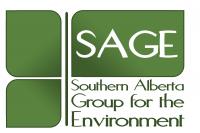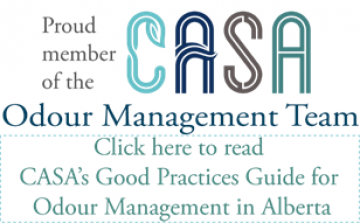Clean Air Strategic Alliance (CASA)
 is a proud member of the Clean Air Strategic Allilance (CASA)
is a proud member of the Clean Air Strategic Allilance (CASA)
ABOUT CASA
Through two decades of dedication, the Clean Air Strategic Alliance (CASA) has emerged as one of Canada’s most productive multi-stakeholder organizations. CASA’s policy advice and regulatory frameworks have had a lasting influence on the management of air quality in Alberta. Decisions and recommendations related to the development of the Good Practices Guide for Odour Management in Alberta have been agreed to by consensus of the multi-stakeholder project team and task groups, who have worked together as equals to develop creative and long-lasting solutions.

Now available in a single resource—a comprehensive reference guide to help industry, regulators and government assess, prevent, mitigate and manage odours and address odour complaints.
The Good Practices Guide for Odour Management in Alberta, developed by the Clean Air Strategic Alliance (CASA), explains some of the most common tools and practices used in assessing, preventing and managing odours. The guide brings together a wealth of information that industry, regulators and government can use to develop odour management plans or requirements.
The guide describes various odour management tools and the general situations and circumstances in which specific tools may be most effective. There are also templates, forms and other resources organizations can use or customize as part of their own odour management processes.
“The guide was prepared with Alberta in mind and it is relevant to our province,” said Humphrey Banack, Vice-President of the Alberta Federation of Agriculture and co-chair of the CASA Odour Management Project Team. “That said, general odour concerns are consistent across many jurisdictions and the tools in the guide can be applied elsewhere, just as we looked at other jurisdictions to find tools that could be used in Alberta.”
Odour is one of the most common air quality complaints and is often a challenging issue to address. Odour sources vary and are often transient in nature, but when odours are detected they can directly and indirectly affect health and quality of life. In addition to the tools mentioned above, the guide provides basic information about odour and its relationship to health. There is also a section devoted to developing a complaint management process.
“As industry changes and operates closer to populated areas, odour management and odour issues are receiving more attention,” said Banack. “The guide provides great information and tools that organizations can use to manage odours and handle complaints, whether they are preparing for a new facility or managing an existing one.”
Decisions and recommendations related to the development of the guide were agreed to by consensus of the multi-stakeholder project team and task groups. CASA will review the guide’s content every five years to ensure it remains relevant, especially with respect to advances in technology.
See related information on our, Confined Feedlot Reports Page.
Many thanks to sage director Ann Baran for her dedication and long hours seeing these projects through.
 is a proud member of the Clean Air Strategic Allilance (CASA)
is a proud member of the Clean Air Strategic Allilance (CASA)




